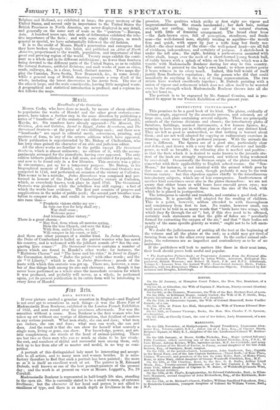fiut
ROSA BONREUR.
If ever picture excited a genuine sensation in England—and England is not over apt to sensations in such things—it was the Horse Fair of Mademoiselle Rosa Bonheur, exhibited in the London French Exhibition of 1855, and sent round over the provinces afterwards. Nor was the sensation without a cause. Rosa Bonheur is the first woman who has taken up art without one vestige of dilettantism, that fatallest of cankers in any serious pursuit. What men study, she can and does; what men can endure, • she can and does ; what men can work, she can and does. And the result is that she can show for herself what scarcely a single man, living or gone, can show. For knowledge, power, and artistic completeness, she stands at the head of animal-painting. There are but two or three men who can so much as claim to be her rivals : the rest, and numbers of skilful and successful men among them, only look up to her from afar off as master and model, in no way as competitor. A portrait of this distinguished lady must be interesting and acceptable to all artists, and to many men and women besides. It is satisfactory therefore to find that such a portrait has been painted; the more so as it is itself an excellent work of art. The painter is M. Edouard Dubnfe, well known as one of the best portrait-painters of the present day ; and the work is at present on view at Messrs. Leggatt's, No. 79 Comhill.
Mademoiselle Bonheur is represented in half-length life size, standing in the open air. She is currently stated to be a small woman, of extreme liveliness; but the character of her head and person is not allied to smallness of type, and there is as much depth as liveliness in the ex pression. The qualities which strike at first sight are vigour and impressionableness. She stands bareheaded ; her dark hair, neither straight nor curling, taking care of itself in natural clusters, and with little of feminine arrangement. The broad clear brow —the dark-brown eyes, full of perception, steadiness, and frankness—the well-formed nose, slightly tending to aquiline—the mouth firm and quick, with upper lip just a trifle long but finely modelled—the clear round of the thin—the well-poised head—are all full of vividness, independence, and certainty of purpose. A sketch-book is under the left arm; the right, holding a porte-crayon mounted with white chalk, hangs over the neck of a short-horned young Scotch bull, of ruddy brown with a splash of white on his forehead, which was a favourite with Mademoiselle 13onheur during her stay in this country. The animal is painted by the lady's own hand; to whose perfect power it bears witness in its every touch. Indeed, this bull would of itself justify Rosa Bullhorn's reputation; for the person who did that could manifestly do anything in the way of living representation. The two artists have winked excellently together ; M. Dula& painting with ft union of vigour and refinement which does not allow itself to be worsted even by the strength which Mademoiselle Bullhor throws into all sho sets her hand to.
The portrait is to be engraved by Mr. Samuel Cousins, and is promised to appear in our French Exhibition of the present year.


























 Previous page
Previous page